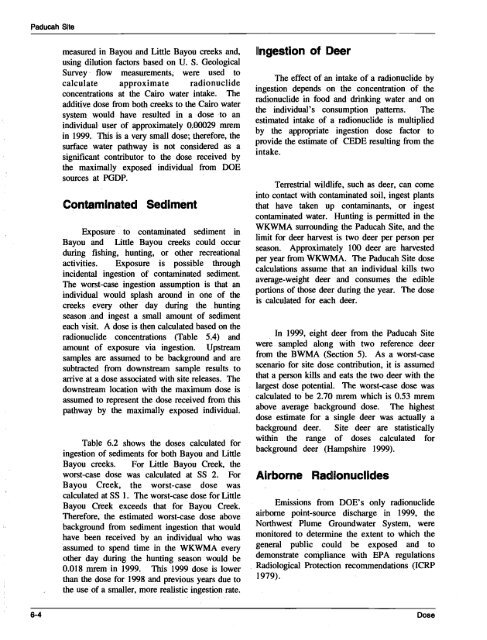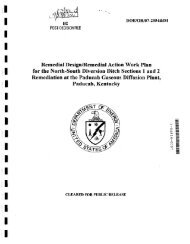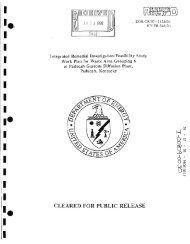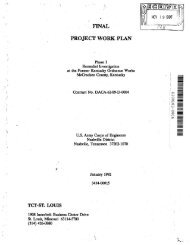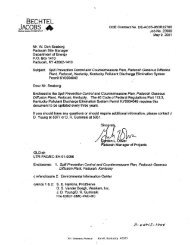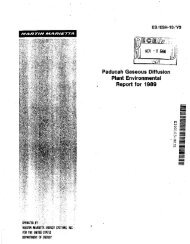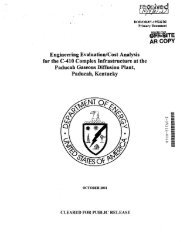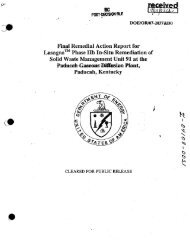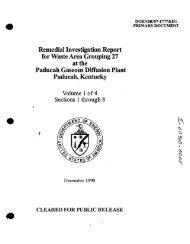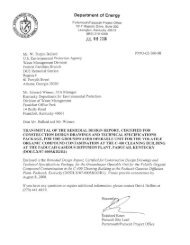1 - paducah environmental information center
1 - paducah environmental information center
1 - paducah environmental information center
You also want an ePaper? Increase the reach of your titles
YUMPU automatically turns print PDFs into web optimized ePapers that Google loves.
Paducah Site<br />
measured in Bayou and Little Bayou creeks and,<br />
using dilution factors based on U. S. Geological<br />
Survey· flow measurements, were used to<br />
calculate approximate radio nuclide<br />
concentrations at the Cairo water intake. The<br />
additiv.e dose from both creeks to the Cairo water<br />
system would have resulted in a dose to an<br />
individual> user of approximately 0;00029 mrem<br />
in 1999. This is a very small dose; therefore, the<br />
surface water pathway is not considered as a<br />
significant contributor to the dose received by<br />
the maximally exposed individual from DOE<br />
sources at PGDP.<br />
Contaminated Sediment<br />
Exposure . to contaminated sediment in<br />
Bayou and Little Bayou creeks could occur<br />
during fishing, hunting, or other recreational<br />
activities. Exposure is possible through<br />
incidental ingestion of contaminated sediment.<br />
The worst-case ingestion assumption is that an<br />
individual would splash around in one of the<br />
creeks every other day during the hunting<br />
season and ingest a small amount of sediment<br />
each visit. A dose is then calculated based on the<br />
radionudide concentrations (Table 504) and<br />
amount of exposure via ingestion. Upstream<br />
samples are assumed to be background and are<br />
subtracted from downstream sample results to<br />
arrive at a dose associated with site releases. The<br />
downstream location with the maximum dose is<br />
assumed to represent the dose received from this<br />
pathway by the maximally exposed individual.<br />
Table 6.2 shows the doses calculated for<br />
ingestion of sediments for both Bayou and Little<br />
Bayou creeks. For Little Bayou Creek, the<br />
worst-case dose was calculated at SS 2. For<br />
Bayou Creek, the worst-case dose was<br />
calculated at SS 1. The worst-case dose for Little<br />
Bayou Creek exceeds that for Bayou Creek.<br />
Therefore, the estimated worst-case dose above<br />
background from sediment ingestion that would<br />
have been received by an individual who was<br />
assumed to spend time in the WKWMA every<br />
other day during the hunting season would be<br />
0.018 mreril in 1999. This 1999 dose is lower<br />
than the dose for 1998 and previous years due to<br />
the use of a smaller, more realistic ingestion rate.<br />
Ingestion of Deer<br />
The effect of an intake of a radionuclide by<br />
ingestion depends on the concentration of the<br />
radionuclide in food and drinking water and on<br />
the individual's consumption patterns. The<br />
estimated intake of a radionuclide is multiplied<br />
by the appropriate ingestion dose factor to<br />
provide the estimate of CEDE resulting from the<br />
intake.<br />
Terrestrial wildlife, such as deer, can come<br />
into contact with contaminated soil, ingest plants<br />
that have taken up contaminants, or ingest<br />
contaminated water. Hunting is permitted in the<br />
WKWMA surrounding the Paducah Site, and the<br />
limit for deer harvest is two deer per person per<br />
season. Approximately 100 deer are harvested<br />
per year from WKWMA. The Paducah Site dose<br />
calculations assume that an individual kills two<br />
average-weight deer and consumes the edible<br />
portions of those deer during the year. The dose<br />
is calculated for each deer.<br />
In 1999, eight deer from the Paducah Site<br />
were sampled along with two reference deer<br />
from the BWMA (Section 5). As a worst-case<br />
scenario for site dose contribution, it is assumed<br />
that a person kills and eats the two deer with the<br />
largest dose potential. The worst-case dose was<br />
calculated to be 2.70 mrem which is 0.53 mrem<br />
above average background dose. The highest<br />
dose estimate for a single deer was actually a<br />
background deer. Site deer are statistically<br />
within the range of doses calculated for<br />
background deer (Hampshire 1999).<br />
Airborne Radionuclides<br />
Emissions from DOE's only radionuclide<br />
airborne point-source discharge in 1999, the<br />
Northwest Plume Groundwater System, were<br />
monitored to determine the extent to which the<br />
general public could be exposed and to<br />
demonstrate compliance with EPA regulations<br />
. Radiological Protection recommendations (ICRP<br />
1979).<br />
6-4<br />
Dose


